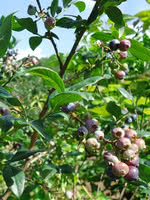Mon-Fri 9am - 5pm Mountain time
Black Elderberry vs Blue Crop Blueberry
Sambucus canadensis
Vaccinium corymbosum Blue Crop
NOT AVAILABLE THIS SEASON - MIGHT RETURN
Black Elderberry is a deciduous shrub native to eastern North America. You can plant this shrub in moist areas and it will help stabilize your soil. You can also use it on rural properties anywhere you'd use a lilac.
Black Elderberries are considered to be partially self-pollinating. So while they will still produce some berries without cross-pollination, planting with another variety will increase yields. Consider planting with Ranch Elderberry or Bob Gordon Elderberry.
Warning: the seeds, stems, leaves, roots, and uncooked berries of the Black Elderberry are poisonous to humans when eaten in quantity. You should cook the berries to make them safe for human consumption.
Blue Crop Blueberry is a high yielding, commercial highbush blueberry variety that is widely planted. If you're lucky enough to live in a suitable climate zone, Blue Crop Blueberry is a great choice. Its very large berries taste amazing. They are very firm and store well.
While this variety is self-pollinating, we recommend pairing Blue Crop Blueberry with another Blueberry to increase the berry production of both varieties.
You must prune Blue Crop Blueberry to maintain its health and productivity.
Note: Blueberries require very specific soil conditions. They need well-drained soil with a pH between 4.5 and 5.0.
Black Elderberry Quick Facts
Blue Crop Blueberry Quick Facts
Toxicity: leaves, stems, and uncooked berries are poisonous to humans

